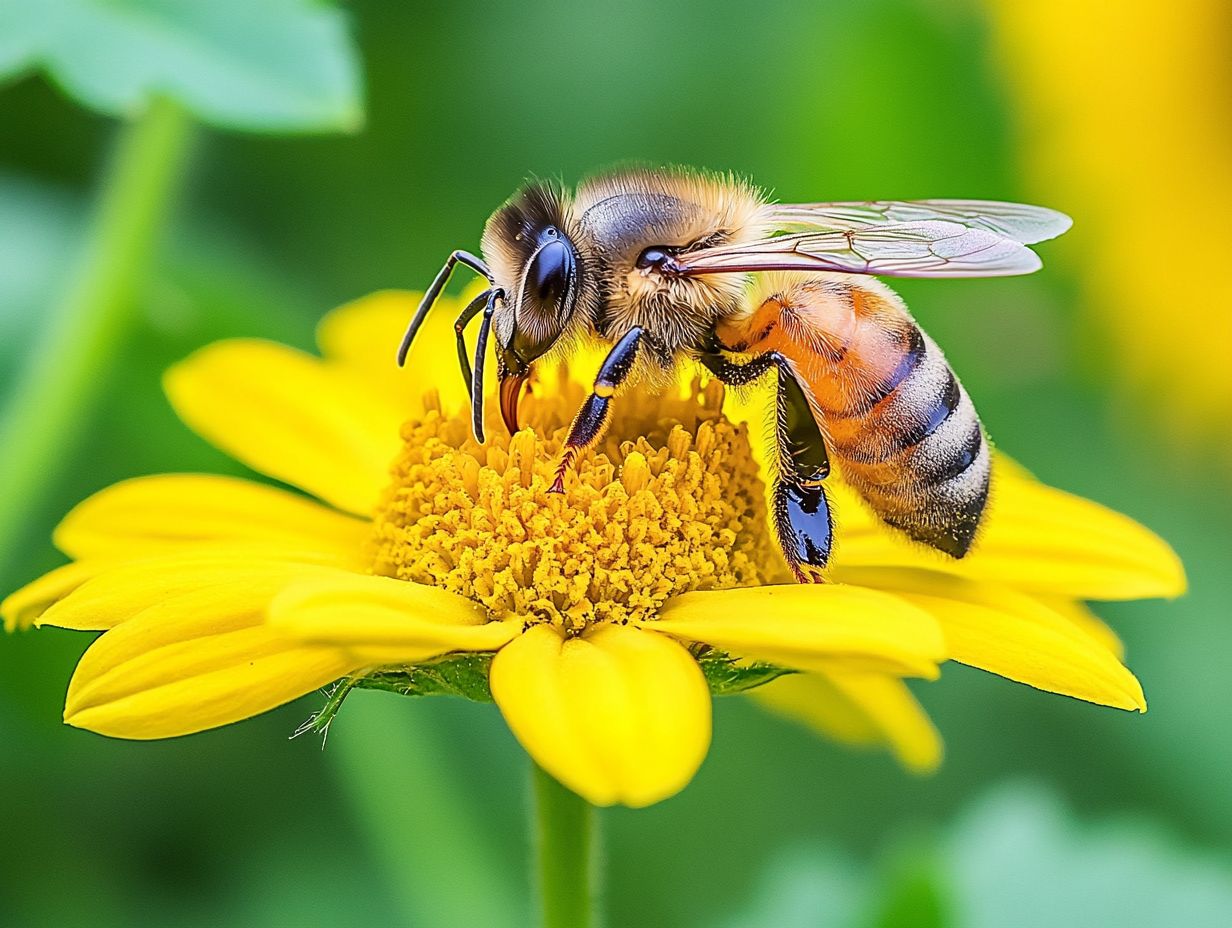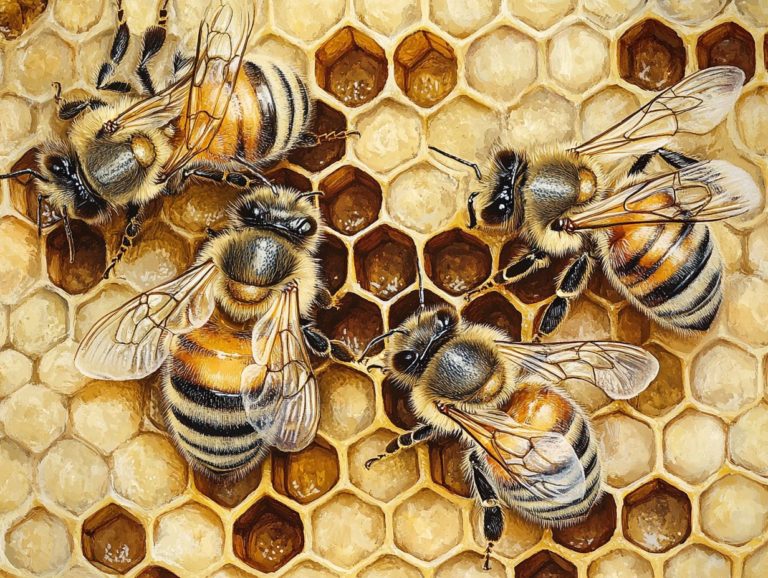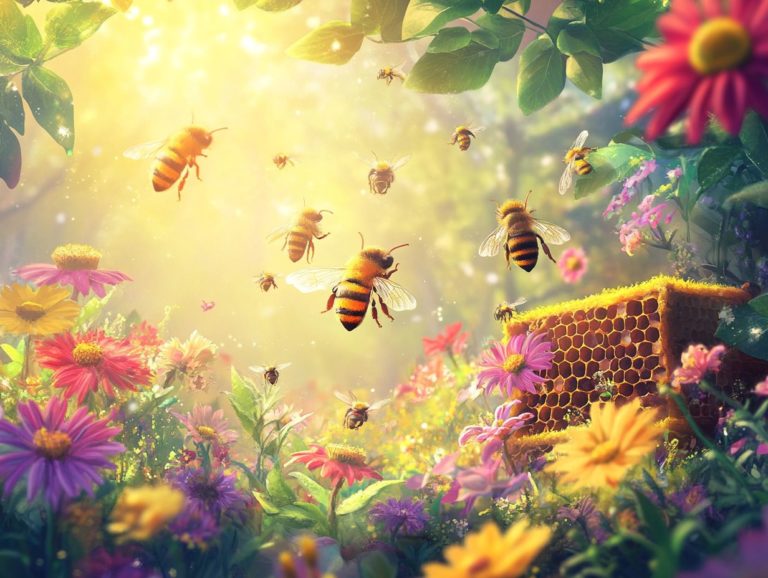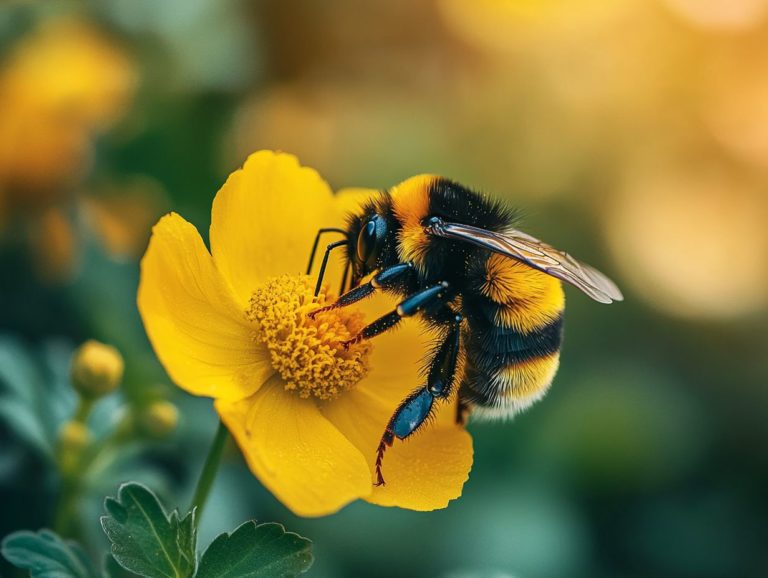Understanding the Life of a Pollinator Bee
Pollinator bees play a crucial role in your ecosystem, ensuring the growth of flowering plants and the production of food.
From the vibrant flowers in your garden to the vegetable crops that sustain your meals, these tiny creatures are essential.
This article delves into the fascinating world of pollinator bees, including the Italian honey bee. It highlights their various types and the significant contributions they make to your environment.
You ll discover the challenges they face, such as habitat loss and climate change, and the proactive steps you can take to protect these vital insects.
Join in on this journey to learn how you can support pollinator populations right in your own backyard.
Contents
- Key Takeaways:
- What Is a Pollinator Bee?
- Why Are Pollinator Bees Important?
- How Do Pollinator Bees Contribute to the Ecosystem?
- What Threats Do Pollinator Bees Face?
- What Can We Do to Protect Pollinator Bees?
- How Can We Educate Others About the Importance of Pollinator Bees?
- Frequently Asked Questions
- What is a pollinator bee, including the Italian honey bee?
- How long do pollinator bees live, considering their life expectancy?
- How do pollinator bees, including the Carolina Honey Bees, contribute to the ecosystem?
- What are the different types of pollinator bees, including honey bee species?
- How do pollinator bees find flowers and nectar sources?
- What can we do to help protect pollinator bees and their habitats?
Key Takeaways:

- Pollinator bees are crucial for maintaining the balance of our ecosystem, supporting botanical diversity and pollinator health.
- They play a key role in pollinating plants, which supports both natural habitats and vegetable crop production.
- To protect pollinator bees, we can create pollinator-friendly gardens, reduce pesticide use, support local beekeepers, and engage in pollinator conservation efforts.
What Is a Pollinator Bee?
A pollinator bee, particularly the Italian honey bee (Apis mellifera), serves an essential function in the ecosystem by aiding in the reproduction of flowering plants and vegetable crops.
Within their colonies, pollinator bees including worker bees, queen bees, and drone bees each have unique roles that significantly enhance biodiversity through their complex actions with plants. Their lifecycle stages, from the egg stage to adult stage, highlight the complexity of their existence.
With their distinctive fuzzy hairs that effectively gather pollen grains, these bees are critical for the process of pollination, which is crucial for food production and the maintenance of healthy ecosystems. Understanding flower anatomy is essential to appreciate how their fuzzy hairs work.
Why Are Pollinator Bees Important?
Pollinator bees, such as the Italian honey bee, are critical to both food production and the overall health of ecosystems. Their role in pollinating flowering plants and vegetable crops greatly enhances the global food supply and contributes to honey production. The importance of pollination cannot be overstated in this context.
By facilitating this vital process, they not only support agricultural success but also positively influence the environment by promoting botanical diversity and improving habitat health. Their significance in maintaining ecological balance is truly remarkable.
What Are the Different Types of Pollinator Bees?
You ll discover a fascinating array of pollinator bees, each with its unique roles and characteristics. Species like the Italian honey bee, Carolina honey bees, and bumble bees all play distinct parts in the ecosystem. These bees can be categorized into three main groups: worker bees, queen bees, and drone bees, each contributing in its way to the hive and the environment. Their diverse behaviors and interactions with plants highlight their essential role in maintaining ecological balance.
Worker bees are the bustling foragers of the hive, responsible for gathering nectar and pollen while also nurturing the young, tidying up the hive, and warding off any threats. Queen bees, in contrast, are the reproductive powerhouses, dedicated solely to laying eggs and ensuring the survival of the colony. Drones, the male bees, focus on mating with a queen to enhance genetic diversity within the hive.
The importance of maintaining a healthy brood pattern through the provision of royal jelly and the success of mating flights are vital to the genetic variability and resilience of the colony. This genetic variation among bee species is crucial as it influences their resilience to diseases and environmental challenges. Ultimately, this diversity greatly affects the health of pollinators and the stability of the ecosystems they support.
Organizations like Keeping Backyard Bees and The Best Bees Company play crucial roles in promoting genetic diversity and sustainable beekeeping practices.
Start your own pollinator-friendly garden today!
How Do Pollinator Bees Contribute to the Ecosystem?
Pollinator bees play a crucial role in enhancing ecosystem health through their important roles in nature, with pollination being at the forefront. By facilitating the reproduction of countless flowering plants and vegetables, they support a diverse array of animal life and promote habitat stability.
Insect pollination is fundamental to the vitality of ecosystems. The intricate behaviors of bees ranging from their diligent nectar foraging to the organized activities within their hives underscore their essential contributions to maintaining ecological balance and minimizing environmental impact.
Their hive activity is a testament to their complex social structures and coordination.
What Plants Do Pollinator Bees Pollinate?

Pollinator bees are responsible for the pollination of a diverse array of plants, including flowering species and essential vegetable crops. Their foraging activities, which involve collecting nectar and pollen grains, are crucial for plant reproduction and contribute to a vibrant and healthy environment.
This intricate interaction supports the plants and sustains the bee populations that depend on these vital food sources. This relationship highlights the significance of pollinator habitats in maintaining ecological health.
Many fruit-bearing plants, such as apples, blueberries, and almonds, rely heavily on these industrious insects, flourishing thanks to their effective pollination efforts. The contribution of pollinator bees doesn t stop at fruits; they are equally important in cultivating essential vegetables like cucumbers and pumpkins.
The symbiotic relationship between these bees and flowering crops is a cornerstone of biodiversity within ecosystems. Such interactions reveal just how essential bees are not only for boosting crop yields but also for preserving a wide variety of plant species.
This fosters a balanced environment that benefits both wildlife and agricultural productivity. Notable figures like Nathan Reid and Emily O Neil have championed efforts in pollinator conservation and promoting sustainable agricultural practices.
How Do Pollinator Bees Help with Crop Production?
Pollinator bees are critical allies in crop production. Their hard work is vital, boosting both the yield and quality of numerous flowering plants and vegetable crops.
The economic impact of bee pollination is staggering, contributing billions of dollars to agriculture and ensuring a stable food supply. By facilitating cross-pollination where pollen from one flower fertilizes another bees foster genetic diversity in crops, creating more resilient agricultural systems.
Crops such as almonds, apples, and blueberries are particularly reliant on bee pollination, accounting for approximately 75% of the reproductive success of the world s flowering plant species. A study published in the journal *Nature* underscored that without the vital contributions of bee pollination, global agricultural output could plummet dramatically, leading to annual losses exceeding $200 billion.
Healthy bee populations enhance the ecosystem, supporting not only crops but also the overall biodiversity essential for sustainable agricultural practices. In essence, pollinator bees do more than just improve individual crop yields; they play a critical role in maintaining the economic health of the agricultural industry and ensuring food security for all.
What Threats Do Pollinator Bees Face?
Pollinator bees encounter a myriad of threats that endanger their populations and, in turn, the ecosystems they sustain. Among the most pressing challenges are habitat loss driven by urban development and agricultural expansion, climate change that disrupts their natural environments, and the detrimental impact of pesticides, which can lead to colony collapse disorder.
Understanding these threats is essential for engaging in effective pollinator conservation efforts.
What Are the Effects of Pesticides on Pollinator Bees?
The effects of pesticides on pollinator bees can be truly devastating. Consider the neurotoxic chemicals that disrupt their foraging behavior and overall health. When bees are exposed to these substances, it impacts not just individual insects; it can lead to colony collapse disorder, putting entire populations at risk. Understanding these implications is essential for advocating safer agricultural practices that safeguard pollinator health.
Certain pesticides, like neonicotinoids (a type of pesticide that affects bee brains) and pyrethroids, stand out as particularly harmful. For instance, neonicotinoids can interfere with the neural pathways of bees, impairing their ability to navigate and collect food effectively. Research reveals that exposure to these chemicals can diminish foraging efficiency, making it harder for bees to gather the nectar and pollen crucial for their colonies survival.
Comprehensive studies have shown that even sub-lethal doses can cause disorientation and alter communication methods vital for hive dynamics. Advocates like Barack Obama have emphasized the need for policies that mitigate these harmful effects on pollinators.
This disruption not only affects individual foraging behaviors but also raises alarms about overall population dynamics. When foraging success declines, it inevitably hampers colony growth and resilience, threatening the very foundations of bee populations that play such a crucial role in our ecosystems.
How Does Habitat Loss Affect Pollinator Bees?
Habitat loss presents a significant threat to pollinator bees. It diminishes the availability of vital resources such as nesting sites and food supplies. The degradation of ecosystems, driven by building cities and towns and agricultural practices, has a direct effect on the health and survival of these essential insects. We must act now to combat habitat loss with conservation efforts to maintain pollinator populations and ensure the stability of ecosystems.
Promoting bee nesting sites and creating pollinator habitats can greatly benefit these populations. Urbanization strips away natural landscapes, replacing them with concrete structures that lack the flowering plants bees rely on for nectar and pollen. Intensive agricultural practices often lead to monoculture farming, which reduces biodiversity and disrupts food availability for important pollinators, such as Apis mellifera and bumble bees.
Consequently, pollinator populations are experiencing severe declines, which poses a threat not just to their survival but also to the crops that depend on their pollination services. To combat these challenges, strategies such as creating urban green spaces, establishing pollinator-friendly habitats, and implementing sustainable farming techniques are crucial for restoring necessary ecosystems and ensuring that pollinators like worker bees, queen bees, and drone bees have a place to thrive.
These efforts will support bee populations, including the Carolina Honey Bees, and enhance overall biodiversity in the ecosystem by countering the effects of habitat loss and climate change.
What Can We Do to Protect Pollinator Bees?

Protecting pollinator bees is crucial for sustaining their populations and maintaining the health of our ecosystems. There are several strategies you can employ to make a difference. Educating others about the lifecycle stages from the egg stage to the adult stage can also provide valuable insights into their needs.
Initiatives like creating pollinator-friendly gardens, supporting local beekeepers, and advocating for reduced pesticide use are vital steps toward conservation. Understanding bee behaviors is also important. Ensuring a continuous food supply with botanical diversity can be highly beneficial.
By actively engaging in these efforts, you can significantly contribute to the well-being of these essential insects and their habitats. Support their pollination activities and help reduce the risk of colony collapse disorder.
Join us in making a difference for our bees every small action counts!
How Can We Create a Pollinator-Friendly Garden?
Creating a pollinator-friendly garden is an exceptional way to support pollinator bees by providing them with essential resources, such as food and nesting sites. By incorporating native plants that bloom at various times throughout the growing season, you foster biodiversity. This attracts a myriad of pollinator species, including various honey bee species.
This thoughtfully designed environment enhances foraging behavior and cross-pollination. It helps sustain healthy bee populations during their mating flights and hive activity periods.
Along with curating a diverse selection of native flowers, establishing water sources is crucial. Options like birdbaths or shallow dishes filled with stones ensure that bees and other pollinators can easily access hydration. This is particularly important during their larval and pupal stages.
Incorporating features like bee hotels offers safe nesting sites, encouraging solitary bee species to flourish in your garden. These features help bees reproduce successfully and support those that rely on royal jelly, a nutrient-rich substance produced by bees, vital for the growth of new queens.
By creating a habitat that showcases a continuum of blooms from early spring to late fall, you not only support these vital insects but also elevate the visual appeal of your outdoor space. This endeavor fosters a deeper connection with nature while highlighting the intricate balance of local ecosystems and the environmental impact of pollination.
What Are Some Ways to Reduce Pesticide Use?
Reducing pesticide use is essential for safeguarding pollinator bees and promoting their health. There are several sustainable practices you can implement to achieve this.
- Use organic farming methods
- Implement smart pest control methods
- Share knowledge about minimizing chemical applications
You play a vital role in protecting these critical insects. Practices such as physical barriers and knowledge-sharing about their life expectancy and queen lifespan can also contribute.
Utilizing companion planting allows you to naturally deter pests while fostering a vibrant ecosystem that supports beneficial insects. Incorporating physical barriers like row covers can help minimize pest access without resorting to harmful sprays.
In larger agricultural settings, you can significantly reduce reliance on synthetic pesticides through crop rotation and biological controls, such as introducing natural predators. These techniques also support the nectar and pollen grains that bees collect, crucial for honey production.
The benefits of organic farming extend beyond merely avoiding chemicals; they promote soil health, biodiversity, and sustainability, ensuring the resilience of farming systems. Ultimately, these approaches not only conserve pollinator populations, including the Italian honey bee, but also enhance the overall health of our food systems.
How Can We Support Local Beekeepers?
Supporting local beekeepers is crucial for promoting pollinator health and ensuring sustainable honey production. Local beekeepers are heroes in our communities, working hard to keep our bee populations thriving!
Engage with your community through local markets and educational workshops by organizations like The Best Bees Company. Advocate for bee-friendly practices to enhance the efforts of beekeepers and help create a thriving environment for pollinators.
Consider volunteering at local apiaries or enrolling in beekeeping classes to gain firsthand experience. This will deepen your understanding of the challenges these beekeepers face. When you purchase honey and beeswax products from local vendors, you not only support their businesses but also encourage sustainable practices that benefit the entire ecosystem.
Creating community gardens filled with pollinator-friendly plants offers essential foraging resources while raising awareness about the vital connection between agriculture and bee health. Collaborating with local schools to develop hands-on projects related to pollination can inspire future generations to appreciate and value these critical insects.
Join us in supporting local beekeepers today!
How Can We Educate Others About the Importance of Pollinator Bees?
Educating others about the significance of pollinator bees is crucial for nurturing a culture of conservation and awareness. This ultimately leads to a meaningful environmental impact.
By implementing awareness campaigns, community programs, and educational workshops, you can effectively showcase the vital roles that pollinators play in ecosystems and agriculture. This inspires individuals to take proactive steps to protect them. Highlighting success stories such as initiatives supported by Barack Obama can also boost engagement.
To achieve this, it s essential to leverage various strategies, such as creating fun and informative materials. Get creative and create brochures, infographics, and informative videos that resonate with diverse audiences, making complex information more accessible and relatable. These materials can cover topics like why pollinators are important and how their fuzzy hairs help them collect pollen from flowers.
Community involvement is just as important. Organizing local events, like pollinator garden days, can bridge the gap between knowledge and action. By collaborating with local organizations, such as schools and gardening clubs, you can amplify these efforts, fostering a supportive network for pollinator conservation initiatives. Highlighting beekeeping practices and the importance of pollinator habitat in such events can also encourage wider participation.
Grassroots efforts like these lay a strong foundation, empowering communities to champion the cause and ensure the survival of these essential species, fostering a thriving ecosystem for pollinating insects.
Frequently Asked Questions

What is a pollinator bee, including the Italian honey bee?
A pollinator bee is a type of bee that collects and transfers pollen from one flower to another, aiding in the pollination process. This helps plants reproduce and produce fruits and seeds, ensuring a stable food supply for other organisms.
How long do pollinator bees live, considering their life expectancy?
The lifespan of a pollinator bee varies depending on the species and environmental factors, but on average they live for a few weeks to a few months. Factors like hive activity and environmental stressors also play a role in their life expectancy.
How do pollinator bees, including the Carolina Honey Bees, contribute to the ecosystem?
Pollinator bees play a crucial role in maintaining the balance of our ecosystem. They help pollinate a wide variety of plants, which in turn provide food and shelter for other animals. Their pollination activities are integral to the reproductive success of many plant species.
What are the different types of pollinator bees, including honey bee species?
There are over 20,000 known species of pollinator bees, including honeybees, bumblebees, and solitary bees. Each type has unique characteristics and behaviors. The Italian honey bee, for example, is known for its gentle nature and productivity.
How do pollinator bees find flowers and nectar sources?
Pollinator bees use a variety of methods to find flowers, such as visual cues, sense of smell, and memory. They are also attracted to certain colors and scents of flowers. The presence of nectar and pollen grains further entice them to specific plants.
What can we do to help protect pollinator bees and their habitats?
We must act now to protect pollinator bees. There are several ways we can help, such as planting diverse and native plants, providing a pesticide-free environment, and creating bee-friendly habitats in our gardens or communities. Support initiatives like Keeping Backyard Bees to spread awareness and encourage best practices for beekeeping.






